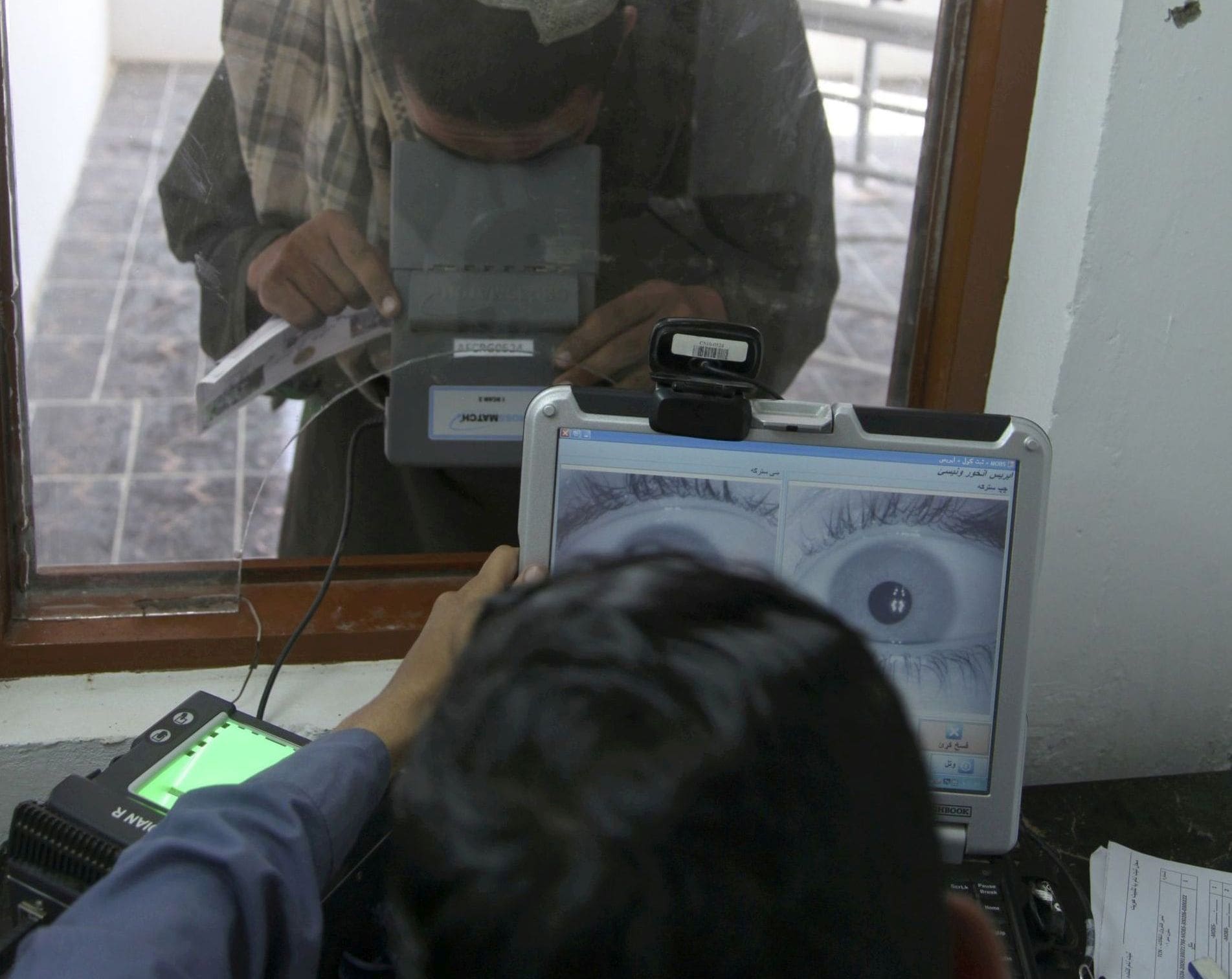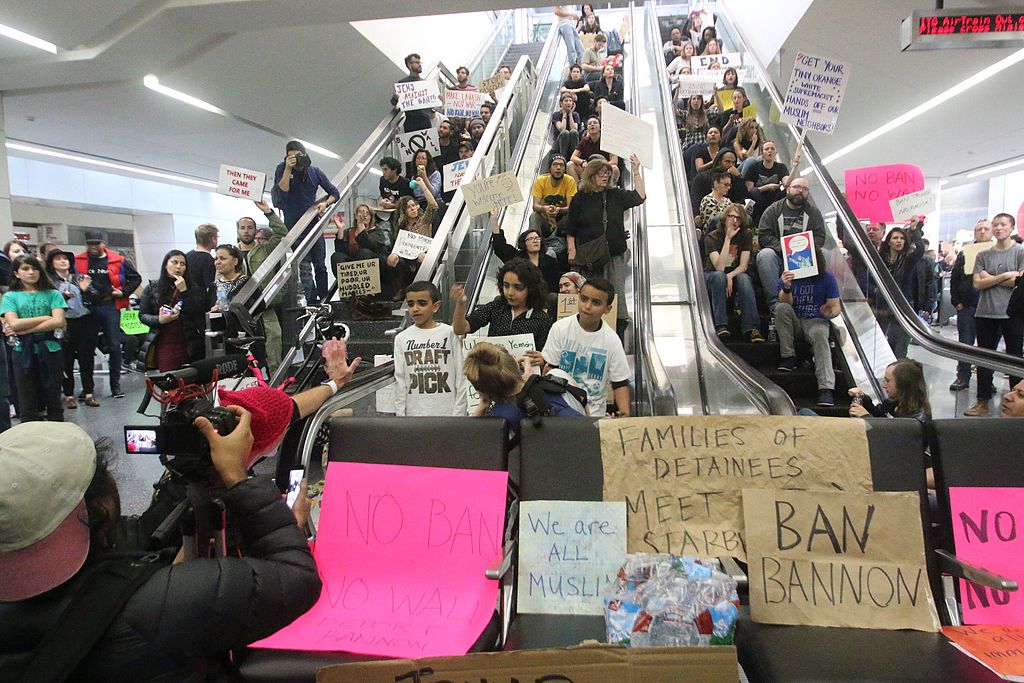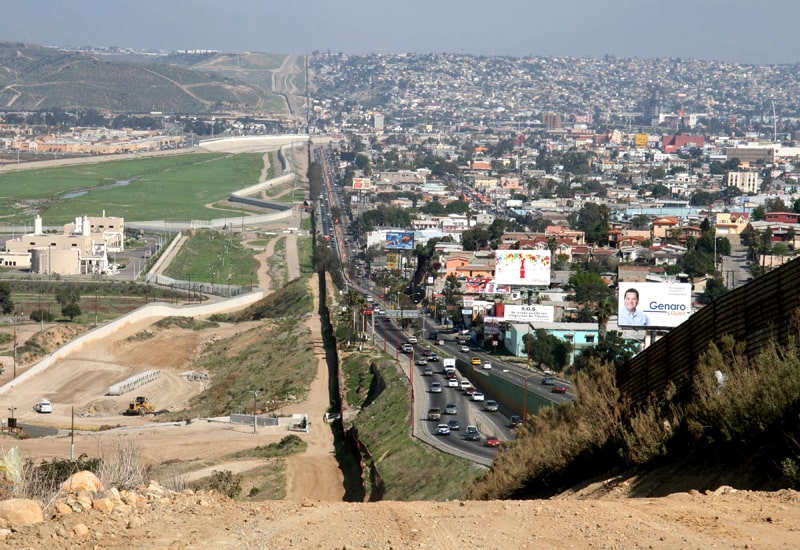
Public Domain, 2011
Local Afghan citizens use the Biometric Eye Scanner, Weesh Border Crossing facility, Afghanistan
Citizenship and Technologies of Bordering
Citizenship makes explicit who is included and who is excluded, both geographically and politically, in our current nation-state system. By examining recent citizenship frameworks and travel regulations in the US, political scientist Kim Rygiel investigates the difficult values that underlie the enforcement of who belongs in a political structure and who does not.
American President Donald Trump once again made headline news with the announcement that his government would halt the processing of all further applications from the 2012 Deferred Action for Childhood Arrivals (DACA) program, which has provided almost 800,000 undocumented young people with a way to regularize their status.Donald J. Trump, “President Donald J. Trump Restores Responsibility and the Rule of Law to Immigration.” Washington: The White House, Office of the Press Secretary, September 5, 2017 [online](https://www.whitehouse.gov/the-press-office/2017/09/05/president-donald-j-trump-restores-responsibility-and-rule-law) [accessed January 11, 2018]. See also: Anonymous, “White House to rescind DACA program protecting young immigrants.” Thomas Reuters and CBC News, September 5, 2017 [online](http://www.cbc.ca/news/world/trump-daca-children-protection-1.4275189) [accessed January 11, 2018]. These included: arrival to the USA before sixteen years of age and under thirty-one years of age at the time of application; attending school and/or military service (with honorable discharge); no criminal record as of 2007. DACA afforded youth the chance to legally work and two-years reprieve from deportation, with the possibility of renewal. See Susan Bibler Coutin et al., “Deferred Action and the Discretionary State: Migration, Precarity and Resistance,” Citizenship Studies (forthcoming). Stripped of DACA status, young people will now become—like other undocumented and irregularized people—more vulnerable to deportation, but with the notable difference that in applying for DACA individuals were required to submit personal information to the government, making it that much easier to now locate and deport them and their family members. This news follows Trump’s so-called “Muslim travel ban” (Executive Order 13769: Protecting the Nation from Foreign Terrorist Entry into the United States), proposing a ninety-day ban on issuing visas to those coming from six Muslim-majority countries including Iran, Libya, Somalia, Syria, Sudan, and Yemen (with Venezuela and North Korea recently added).Donald. J. Trump, “Executive order: Protecting the Nation from Foreign Terrorist Entry into the United States.” Washington: The White House, Office of the Press Secretary, January 27, 2017 [online](https://www.whitehouse.gov/the-press-office/2017/01/27/executive-order-protecting-nation-foreign-terrorist-entry-united-states) [accessed January 11, 2018]. It also proposed a 120-day suspension of the US refugee program (but dropped the original plan of an indefinite ban on Syrian refugees). Critics have rightly noted that this executive order aims to paint entire groups of mobile people, such as Muslims and refugees, as potential security threats, citing President Trump’s December 7, 2015, Press Statement calling for “a total and complete shutdown of Muslims entering the United States.”For example, the judges in Virginia, Maryland, and Hawaii ruled the order unconstitutional because of its “religious bias.” See BBC News, “Trump travel ban: Questions about the revised executive order,” July 14, 2017 [online](http://www.bbc.com/news/world-us-canada-39044403) [accessed January 11, 2018]. For a video recording of President Trump issuing the statement see Helena Horton, “Muslim ban statement ‘removed’ from Donald Trump’s website,” Telegraph, November 10, 2016 [online](http://www.telegraph.co.uk/news/2016/11/10/muslim-ban-statement-removed-from-donald-trumps-website/) [accessed January 11, 2018].
Growing racism and anti-Muslim sentiments and policies in the US have impacted the US–Canadian border as well. Over the past year Canadians have seen a 63 percent increase in asylum claims at the border,Amy Minsky, “Why are asylum seekers crossing into Canada on foot and what are their rights?,” Global News. February 20, 2017 [online](http://globalnews.ca/news/3260988/why-refugees-crossing-canada-us-rights/) [accessed January 11, 2018]. and despite Prime Minister Trudeau’s decision in 2015 to resettle and provide permanent residency (a pathway to citizenship) to some 25,000 Syrian refugees, Canada—like the United States and Europe—has also witnessed a surge in right-wing, anti-immigrant groups like La Meute (The Wolf Pack) and anti-immigrant/refugee/Muslim attacks in public places such as the shooting at a Quebec mosque by a white-supremacist university student, who said he was inspired by Donald Trump.On the far-right in Canada, see Barbara Perry and Ryan Scrivens, “Uneasy Alliances: A Look at the Right-Wing Extremist Movement in Canada,” Studies in Conflict and Terrorism, vol. 39, no. 9 (2016), pp. 819–41. On La Meute’s demonstrations see Jonathan Monpetit, “Far-right group claims PR victory after duelling protests in Quebec City,” CBC news, August 20, 2017 [online](http://www.cbc.ca/news/canada/montreal/quebec-far-right-la-meute-1.4254792) [accessed January 11, 2018].

large
align-left
align-right
delete
These are just a few illustrations of what appears to be a growing and more visible display of xenophobic and racist politics designed to strengthen the borders of belonging between “us and them.” These moments, of course, have much longer histories connected to colonialism, imperialism, and white power;For example, in Canada, feminist activist and writer Robyn Maynard writes about the longer histories of colonization and the violence inflicted on indigenous and black peoples in her new book, Policing Black Lives: State Violence in Canada From Slavery to the Present, first edition, Winnipeg: Fernwood Publishing, 2017. here, however, I want to locate this intensification of bordering within the more recent twentieth-century history of citizenship as a technology of governing populations and regulating movement and mobility rights.
It was Hannah Arendt, writing at the end of two devastating world wars, who articulated so insightfully the problem of the nation-state in relation to the movement of peoples and their rights. To paraphrase, Arendt posed the problem of the nation-state system in this way, that when an individual loses her citizenship, she also loses her ability to claim the inalienable human rights that should be hers simply by virtue of being human. In order to have one’s human rights recognized, in other words, one must first be recognized as belonging to this world. Arendt points out though:
If a human being loses his political status, he should, according to the implications of the inborn and inalienable rights of man, come under exactly the situation for which the declarations of such general rights provided. Actually the opposite is the case. It seems that a man who is nothing but a man has lost the very qualities which make it possible for other people to treat him as a fellow-man.Hannah Arendt, The Origins of Totalitarianism, “new edition with added prefaces.” New York: Harvest Books, 1973, p. 300.
With the spread of the idea of the nation-state to all people and corners of the world as the only possible form of political community, human rights become meaningful only in so far as they can be enacted through political community—in this case the nation-state, as citizenship rights. According to this logic, if one loses his or her political community, one is without recourse to not only rights but the very “right to have rights,” or as Jacques Rancière put it, to be “among the counted.”Jacques Rancière, “Who is the Subject of Man?,” South Atlantic Quarterly, vol. 103, nos 2–3 (2004), pp. 297–310. According to the logic of the nation-state system, “[n]ot the loss of specific rights, then, but the loss of a community willing and able to guarantee any rights whatsoever, has been the calamity which has befallen ever-increasing numbers of people […] Only with a completely organized humanity could the loss of home and political status become identical with expulsion from humanity altogether.”Ibid., p. 297. From this reading, the nation-state system is by design a system that puts people in place, and by doing so also creates outsiders (for example refugees and the stateless). As an organizing infrastructure, citizenship involves more than simply the recognition of status, rights, and duties, the liberal and more common way of understanding modern citizenship. Rather, it also involves a regulatory architecture around the mobility of people between and across states (which Barry Hindess has named the “international management of population”), as well as an organizing rationale justifying why it is acceptable for governments (and their citizens) to treat outsider-foreigners with differential treatment, as deserving of less than citizen-insiders.Barry Hindess, “Citizenship in the International Management of Populations,” American Behavioral Scientist, vol. 43, no. 9 (2000), pp. 1486–97. Furthermore, as a technology of governing people, citizenship is also at its heart a biopolitical order (and some might say political order), whereby if you do not belong to a state you are not recognized as counting in this world, even as a political being with a first right to exist, upon which one can make demands to other rights. Arendt’s insights here about the function of the nation-state system explain in part the crisis in the system we see unfolding daily, with violence inflicted upon refugees and irregular migrants in particular, as discussed earlier in examples of restrictive border controls. This violence is particularly brutal when people on the move are without the protection of a state and thus are deprived of the right to a political existence, that is, to count among the counted, most visible today in the growing deaths—and our collective indifference to them—at Europe’s borders and elsewhere, such as along the US–Mexico border.About deaths at European borders, see Kim Rygiel,“Dying to Live: Migrant Deaths and Citizenship Politics along the European Border,” Citizenship Studies, vol. 20, no. 10 (2016), pp. 545–60; Maurice Stierl, “A sea of struggle: Activist border interventions in the Mediterranean Sea,” Citizenship Studies, vol. 20, no. 10 (2016), pp. 561–78; Simon Robins, Iosif Kovras, and Anna Vallianatou, Addressing Migrant Bodies on Europe’s Southern Frontier: An Agenda for Research and Practice. Belfast: The University of York Centre for Applied Human Rights, Queen’s University at Belfast, 2014. On the US–Mexican border, see Vicki Squire, “Desert ‘Trash’: Posthumanism, Border Struggles, and Humanitarian Politics,” Political Geography, vol. 39 (2014), pp. 11–21; Leanne Weber and Sharon Pickering, Globalization and Borders: Death at the Global Frontier. Basingstoke: Palgrave Macmillan, 2011; Amanda Holpunch “Migrant deaths at US–Mexico border increase 17% this year, UN figures show,” Guardian, August 5, 2017 [online](https://www.theguardian.com/us-news/2017/aug/05/migrants-us-mexico-border-deaths-figures) [accessed January 11, 2018].

large
align-left
align-right
delete
If today’s more ugly moments have roots in much longer histories of bordering, such as through state citizenship regimes, the current moment is compounded by the role that new technologies now play in creating virtual or electronic borders (e-borders). Technologies such as data aggregation and management, biometrics, and risk profiling are increasingly employed in the service of border management to not only identify individuals, but also to then evaluate them based on notions of desirability and risk. While many of us who live in democratic regimes would view both government and private corporate surveillance of domestic populations as worrisome, if not problematic, such technologies are often acceptable when it comes to their use for governing people on the move, whether as travelers or refugees. The intensification of regulating mobility rights, moreover, comes at a time when movement is one of the few lifelines available for many fleeing war, violence, oppression, and poverty. Movement is a way of responding to the inherent injustice of what Ayelet Shachar calls one’s “birthright lottery,” or the fact that the chance-circumstances of where one is born determine the opportunities and quality of one’s life.Ayelet Shachar, The Birthright Lottery. Cambridge, MA: Harvard University Press, 2009.
Virtual or electronic borders are now integral to many of the border policies, whether it be DACA and population registration—where personal information may be used in the service of speedy deportation—or whether it be through travel bans based on creating new boundaries between “trusted travelers” and risky mobile subjects. Data scientist and mathematician Cathy O’Neil warns against our new fetishism with algorithms; in an interview with her based on her new book Weapons of Math Destruction, O’Neil argues that algorithms not only involve processes of social sorting but also rely on data perceived to be objective, but which in fact is not. This is the case not just in the way data is gathered, the type of data, and how the data is correlated, but also in the ways in which algorithms rely on codification of past histories and practices against which to judge or model possible presents and futures; these histories, of course, are imbued with “systemic biases” of all kinds. The result, as O’Neil explains, is that “We have an infrastructure, probably a well-deserved infrastructure […] whereby we trust science. Science has done a lot for us […] The sleight of hand that’s happened in the big data era is that we think we can manifestly move that technology onto the human sphere. And we can’t.”Cathy O’Neil, Weapons of Math Destruction: How Big Data Increases Inequality and Threatens Democracy. London and New York: Penguin Books, 2017; Interview by Nikhil Sonnad, “Data scientist Cathy O’Neil on the cold destructiveness of big data,” Quartz, December 7, 2016 [online](https://qz.com/819245/data-scientist-cathy-oneil-on-the-cold-destructiveness-of-big-data/) [accessed January 11, 2018]. Unlike in science, when we “predict the movement of stars or moons, we don’t change their movements. But when we predict people—we actually funnel them and channel them into different slots depending on what their score was.” And this, she argues, is no longer about simply prediction, because “we’re actually influencing what they’re going to like. So we’re engendering feedback loops.” As movement across territorial borders becomes increasingly codified with the help of algorithms and other forms of data-management such as biometrics, whether it be through trusted travel passes, airline screening for security, or databases for asylum application like EURODAC, they all depend on perceived “normal” patterns of travel, and concepts of the desirability and undesirability of people, which are steeped in categories (such as risk) that invite biases into the very formulation of algorithms, as can be seen in bloated TSA No Fly lists.
If citizenship provides an organizational infrastructure and rationale for dividing up and regulating the world’s population within nation-states—regulating movement between territorial spaces, and justifying differential access to rights and resources—this architecture is compounded by technologies that have created virtual moving borders to follow bodies as they travel, whether it be inside or outside of the territorial borders of the state. This new matrix of virtual and territorial borders compels us to ask:
“Who is doing the watching? And based on whose authority? For what purpose?”
Click here to insert text for the typewriter
So while we may be employing ever-more virtual technological borders, we should not forget that these also produce new types of guards at the gate too. Lest we become too complacent, if there is anything new in this type of bordering it may be simply the fact that it has wormed its way into our acceptance more insidiously. This is because the new technologies of bordering ask us all to play a role as guards at the gate. As we hand over and submit data, and feel comfortable in our citizenship at the expense of “theirs,” we become, in effect, “securitized citizens.”On this, see Kim Rygiel, “The Securitized Citizen,” in Engin F. Isin (ed.), Recasting the Social in Citizenship. Toronto: University of Toronto Press, 2008, pp. 268–300. Some of the ideas here are also explored in Kim Rygiel, Globalizing Citizenship. Vancouver: UBC Press, 2010, and have been developed in a talk, “Monsters in our Midst: Reflecting on Citizenship Politics and Rights to Movement,” presented as part of Now is the Time of Monsters: What Comes After Nations? Haus der Kulturen der Welt, Berlin, March 23–25, 2017. In doing so, we come to accept a new regime of citizenship defined through the loss of rights to movement. For some of us, the loss is by design. We are made by this system into a refugee, an undocumented, a stateless person, or an “illegal.” For others of us, we lose our rights to mobility (paradoxically, even as we experience more privilege in movement) because we have succumbed to the very idea that mobility should be authorized by governments and the state, and with this, we are one more step away from seeing movement as it was once, and always will be, a part of the natural human condition.